Abstract
After several hours of ischemia an incomplete return of blood flow has been reported in brain, kidney, skeletal muscle, and heart. The mechanisms responsible for the no-reflow phenomenon have been unclear, and perivascular edema, platelet or red cell plugs, and interstitial hemorrhage have been implicated. In the present study evidence is provided that leukocyte entrapment in capillaries might contribute to no reflow. Leukocytes are large and stiff cells, which adhere to vascular endothelium naturally and are known to alter in their adherence properties under a variety of conditions. Accordingly, 11 open-chest dogs were studied, 1-5 hours after left anterior descending coronary artery occlusion. Reperfusion (9 dogs) at 75 mm Hg arterial pressure was accomplished with Ringer's lactate and carbon suspension as a marker for capillary patency. In non-ischemic tissue, 98% of the capillaries contained carbon, rare leukocytes, and few erythrocytes, whereas tissue from the distribution of the occluded artery was heterogeneous: 60% of the capillaries had no carbon, high hematocrits, and approximately one leukocyte per unbranched capillary; 40% demonstrated reflow and no leukocytes. A significant correlation between capillaries without carbon (no reflow) and the frequency of leukocytes remaining in these capillaries indicated that leukocytes were present in obstructed capillaries. Furthermore, the frequency of leukocytes remaining after the washout with lactate was ten times greater than in normal arrested heart muscle without washout. Our results suggest that progressive leukocyte capillary plugging during myocardial ischemia contributes to preventing full restoration of capillary flow upon reperfusion.
Full text
PDF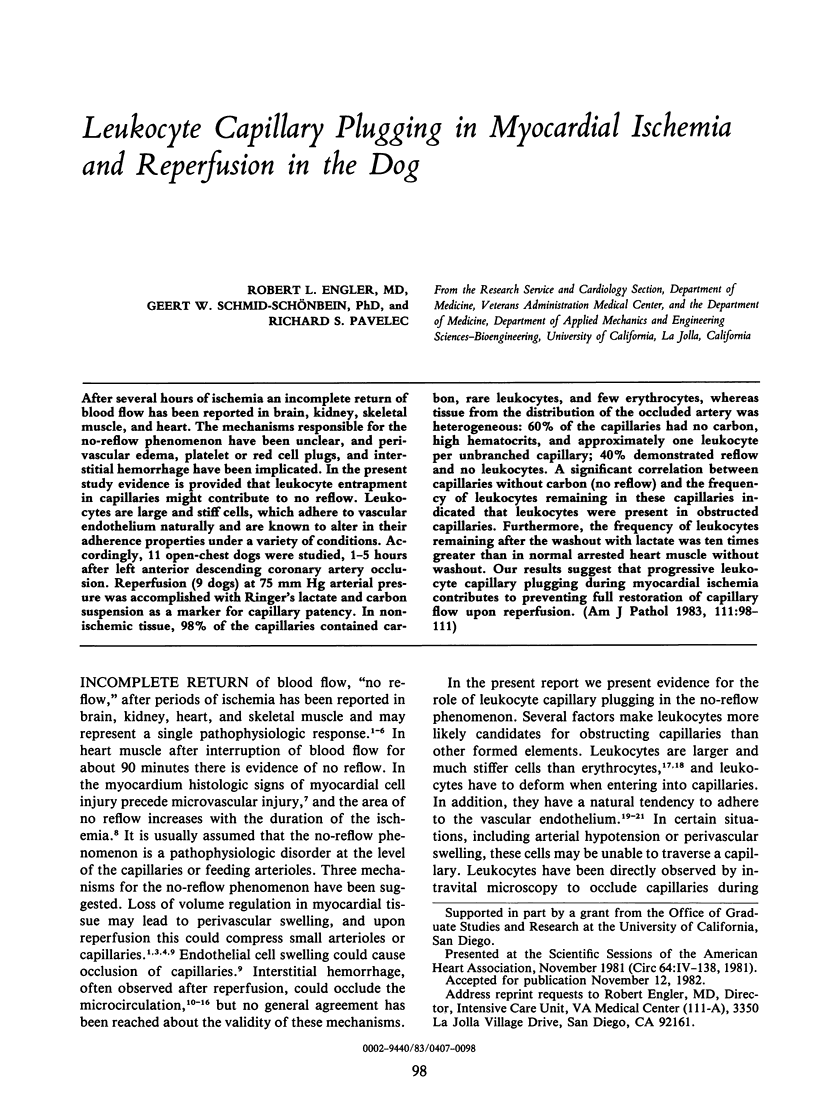
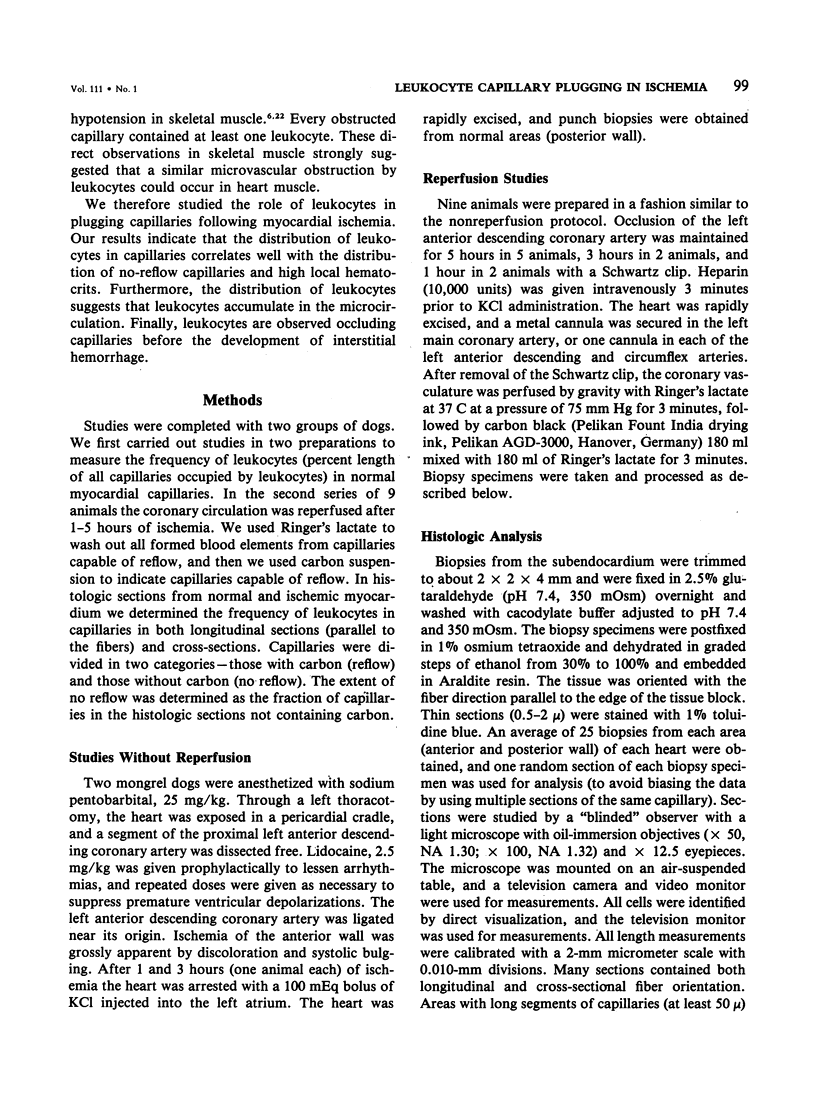
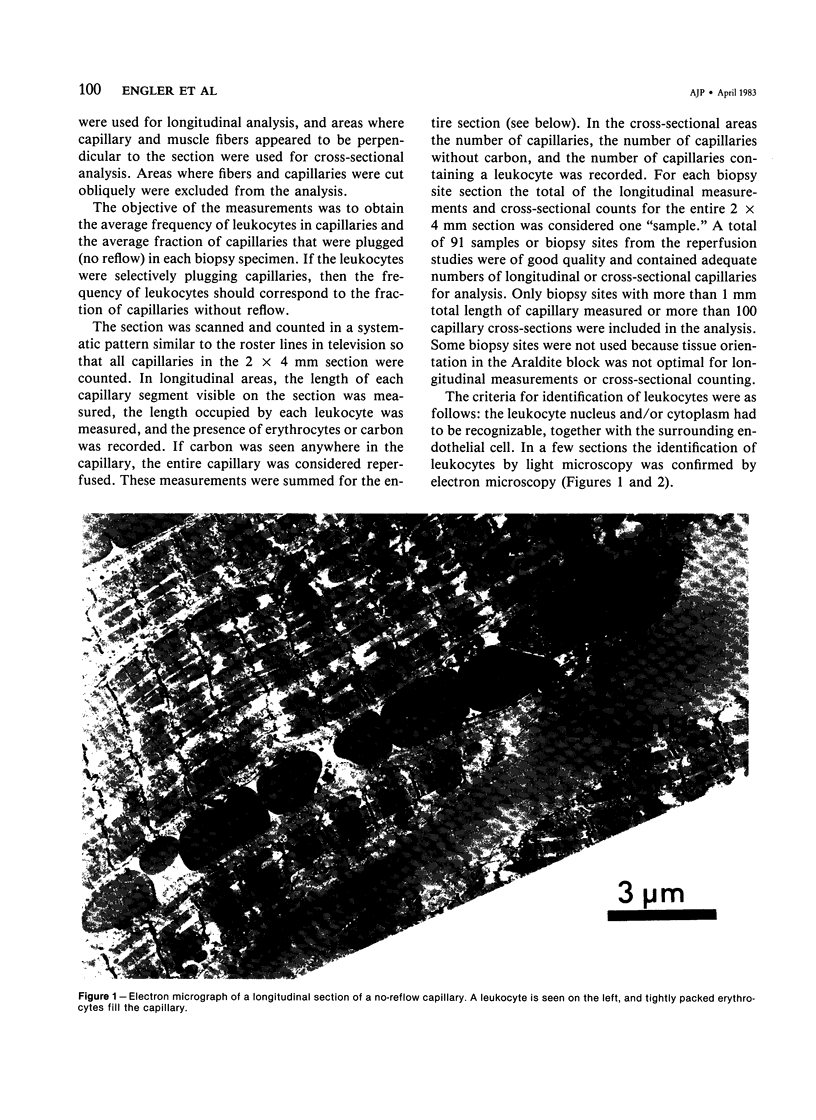
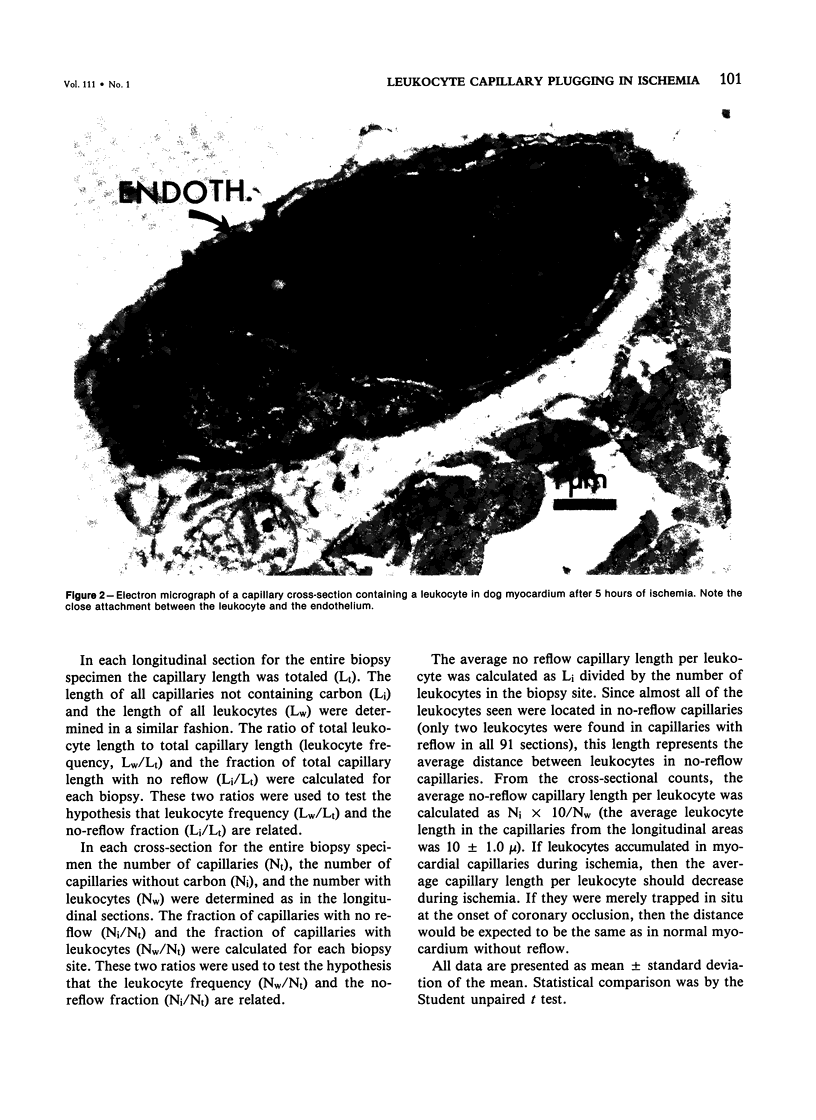
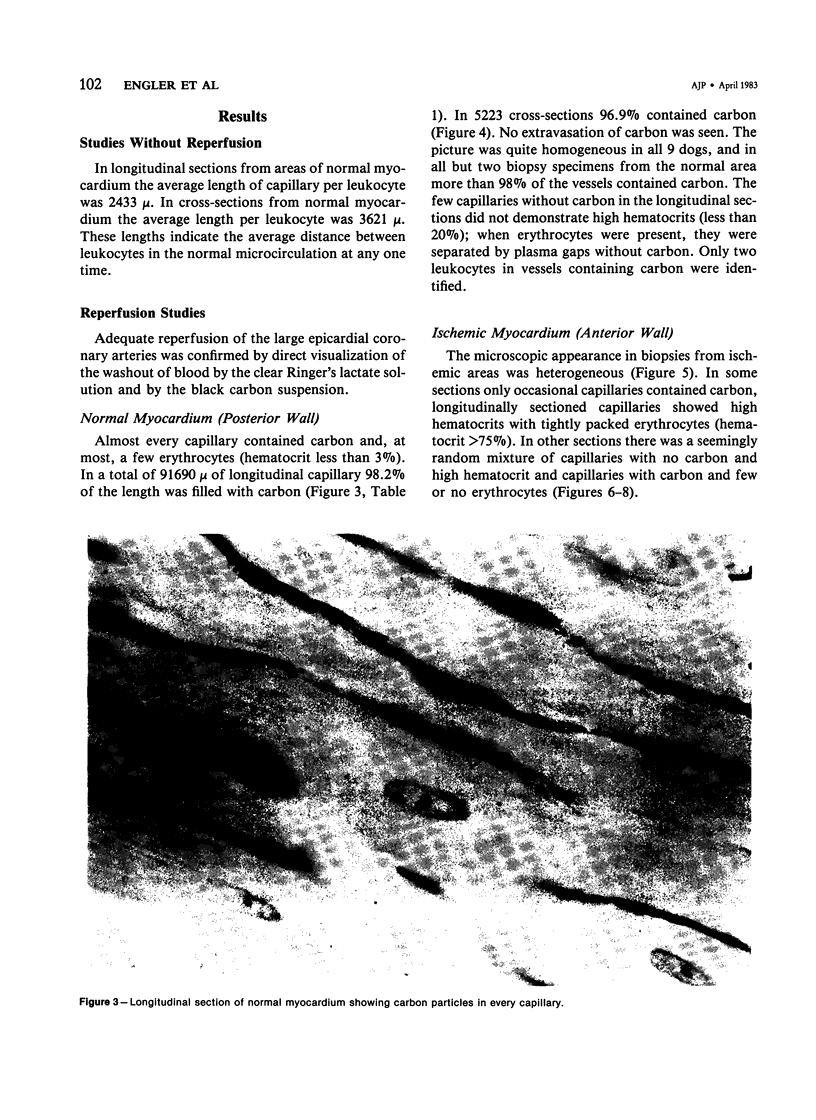
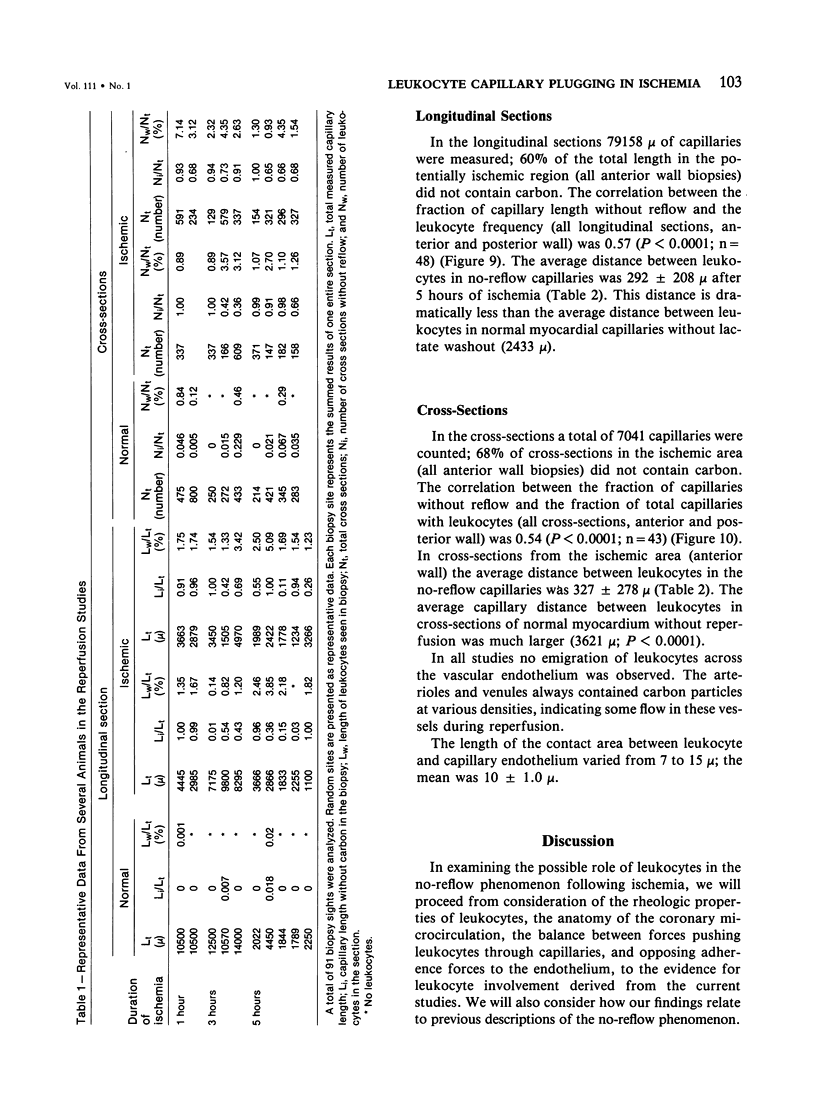
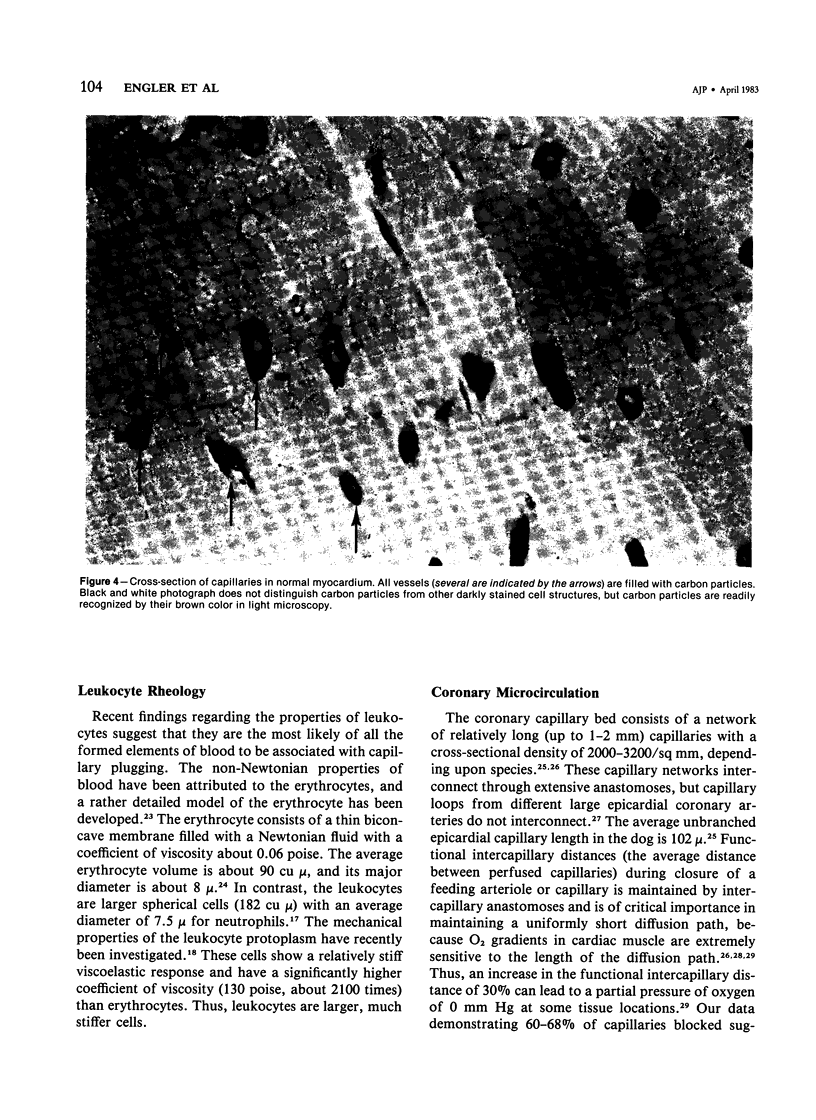
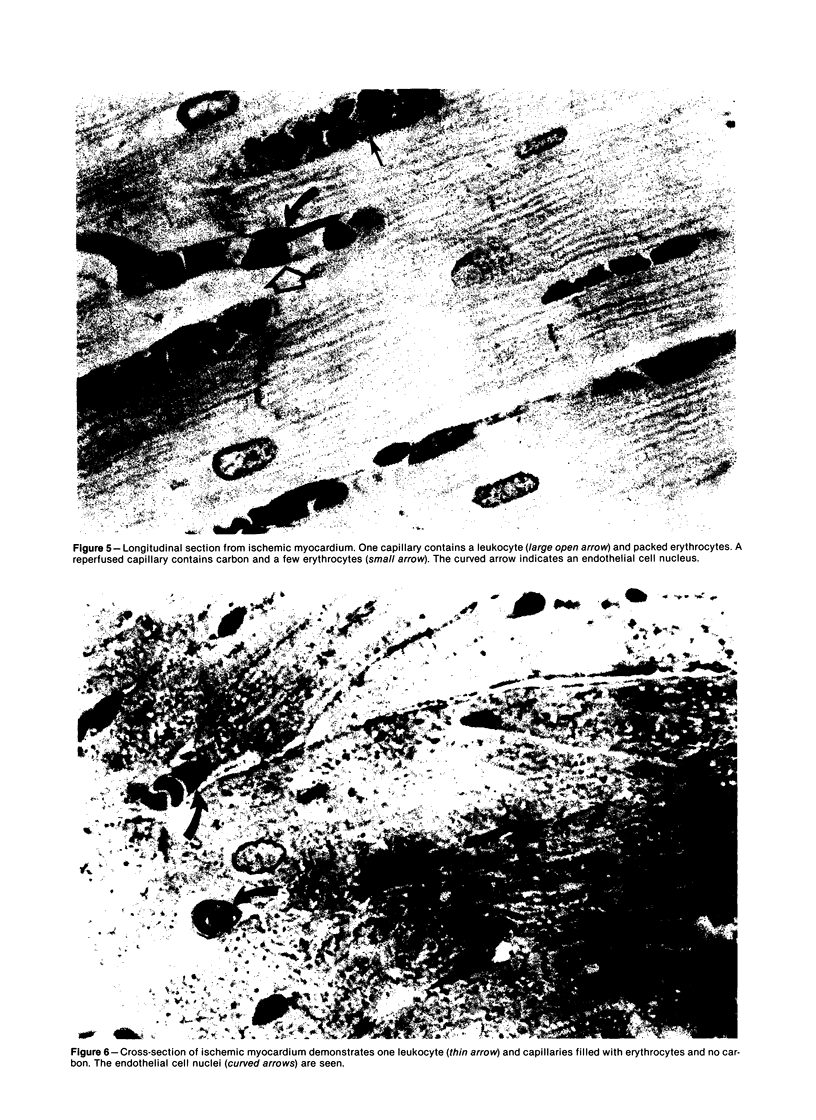
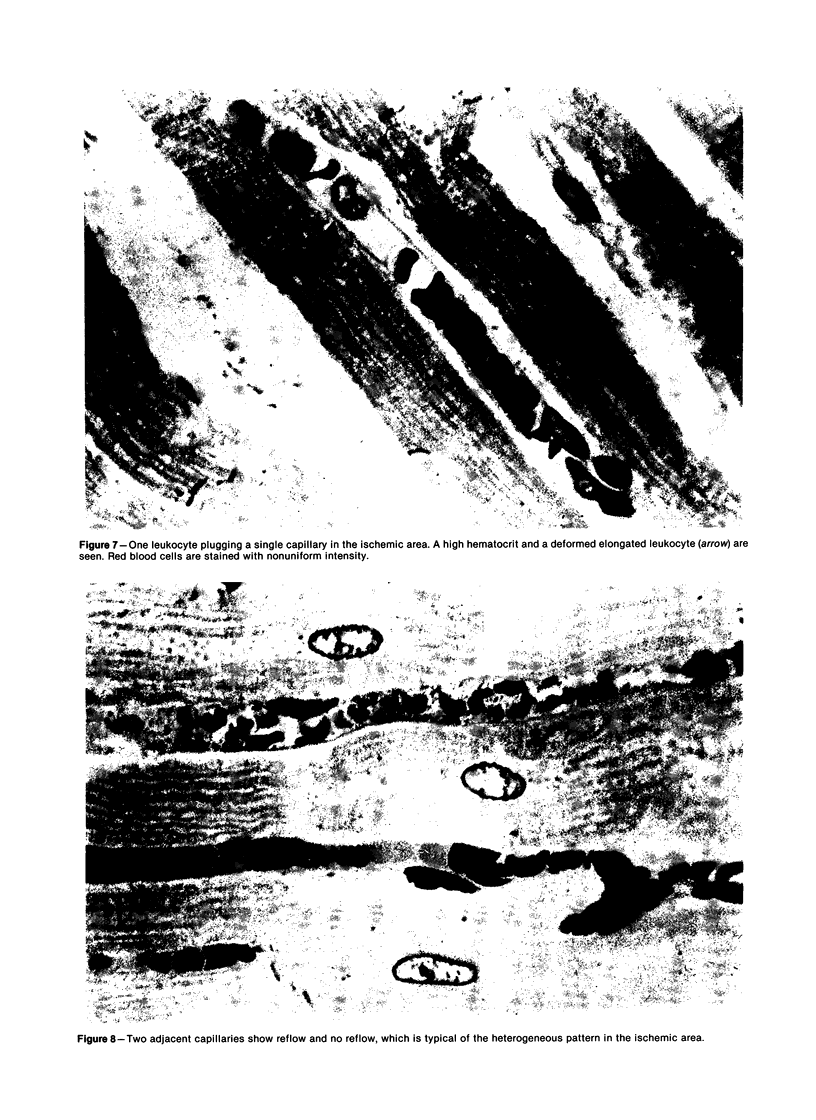
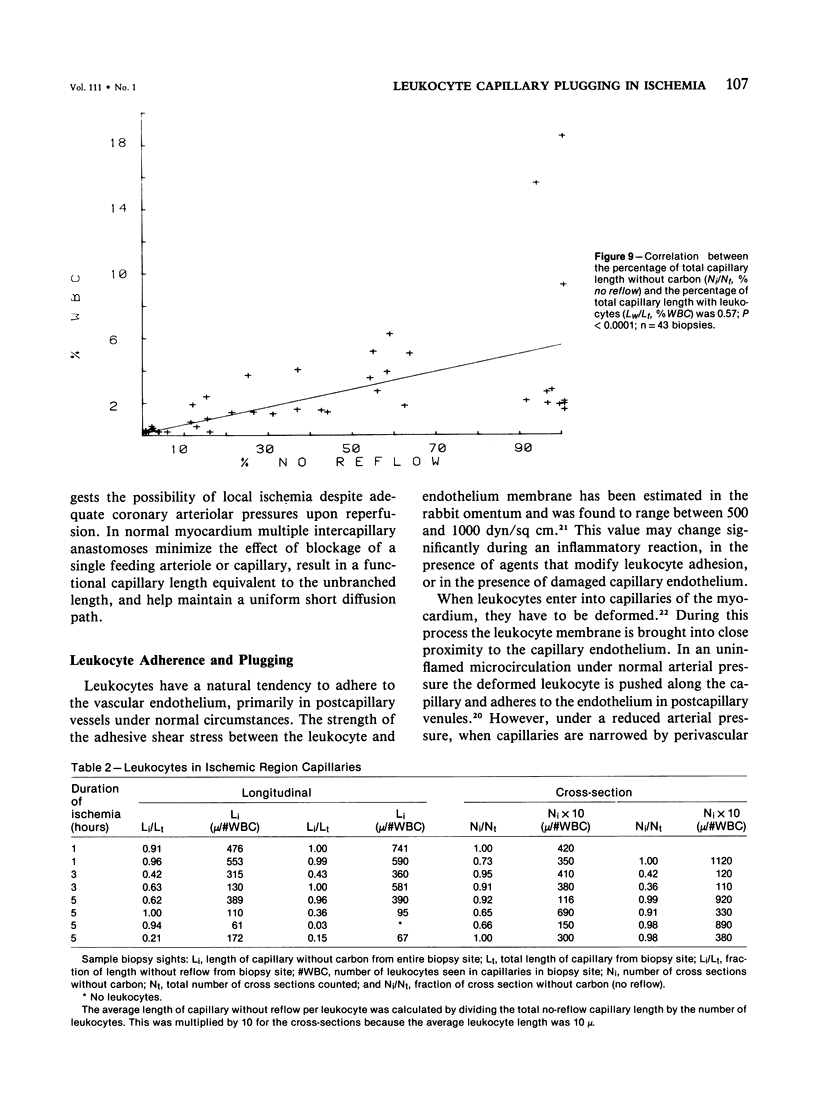
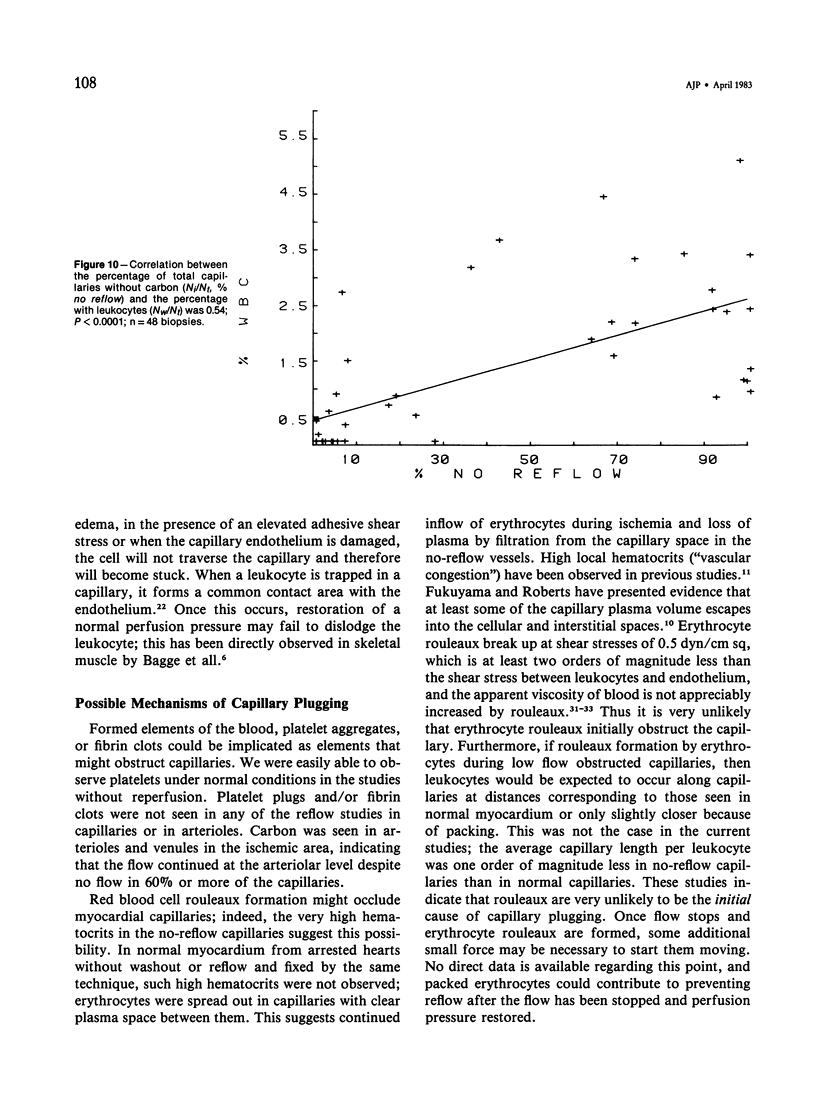
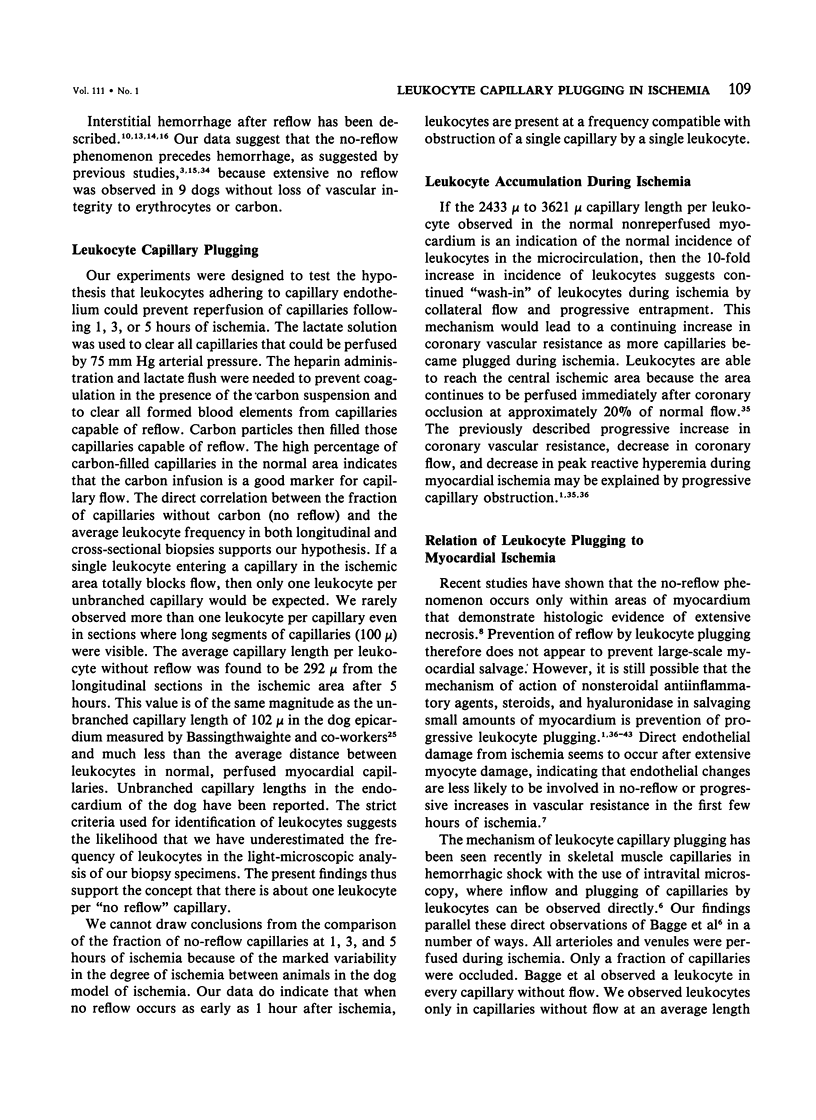
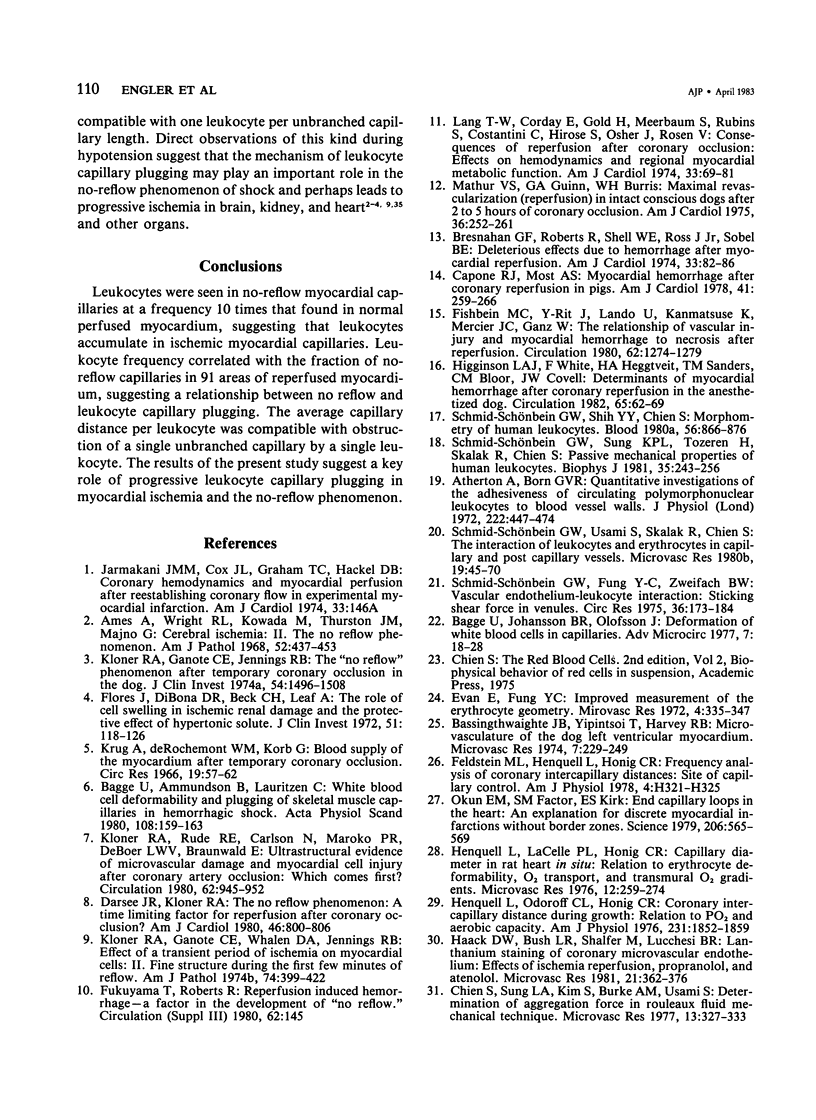
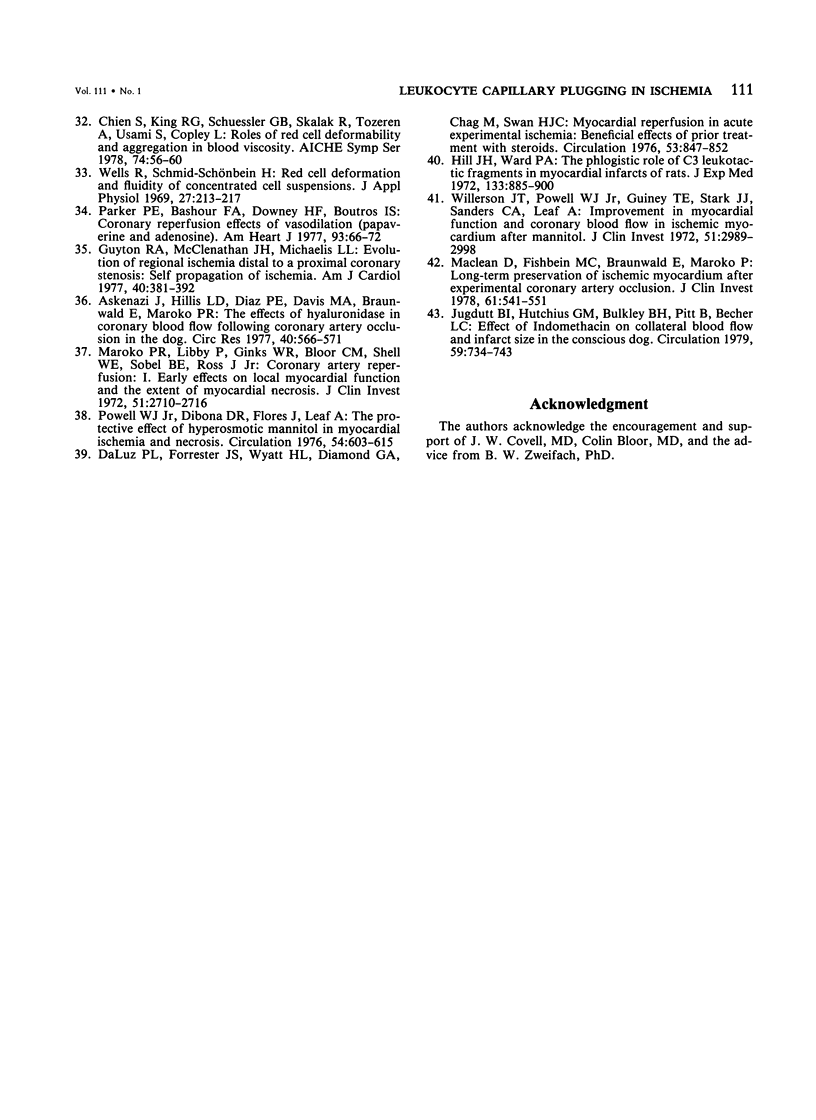
Images in this article
Selected References
These references are in PubMed. This may not be the complete list of references from this article.
- Ames A., 3rd, Wright R. L., Kowada M., Thurston J. M., Majno G. Cerebral ischemia. II. The no-reflow phenomenon. Am J Pathol. 1968 Feb;52(2):437–453. [PMC free article] [PubMed] [Google Scholar]
- Askenazi J., Hillis L. D., Diaz P. E., Davis M. A., Braunwald E., Maroko P. R. The effects of hyaluronidase on coronary blood flow following coronary artery occlusion in the dog. Circ Res. 1977 Jun;40(6):566–571. doi: 10.1161/01.res.40.6.566. [DOI] [PubMed] [Google Scholar]
- Atherton A., Born G. V. Quantitative investigations of the adhesiveness of circulating polymorphonuclear leucocytes to blood vessel walls. J Physiol. 1972 Apr;222(2):447–474. doi: 10.1113/jphysiol.1972.sp009808. [DOI] [PMC free article] [PubMed] [Google Scholar]
- Bagge U., Amundson B., Lauritzen C. White blood cell deformability and plugging of skeletal muscle capillaries in hemorrhagic shock. Acta Physiol Scand. 1980 Feb;108(2):159–163. doi: 10.1111/j.1748-1716.1980.tb06513.x. [DOI] [PubMed] [Google Scholar]
- Bassingthwaighte J. B., Yipintsoi T., Harvey R. B. Microvasculature of the dog left ventricular myocardium. Microvasc Res. 1974 Mar;7(2):229–249. doi: 10.1016/0026-2862(74)90008-9. [DOI] [PMC free article] [PubMed] [Google Scholar]
- Bresnahan G. F., Roberts R., Shell W. E., Ross J., Jr, Sobel B. E. Deleterious effects due to hemorrhage after myocardial reperfusion. Am J Cardiol. 1974 Jan;33(1):82–86. doi: 10.1016/0002-9149(74)90742-5. [DOI] [PubMed] [Google Scholar]
- Capone R. J., Most A. S. Myocardial hemorrhage after coronary reperfusion in pigs. Am J Cardiol. 1978 Feb;41(2):259–266. doi: 10.1016/0002-9149(78)90164-9. [DOI] [PubMed] [Google Scholar]
- Chien S., Sung L. A., Kim S., Burke A. M., Usami S. Determination of aggregation force in rouleaux by fluid mechanical technique. Microvasc Res. 1977 May;13(3):327–333. doi: 10.1016/0026-2862(77)90098-x. [DOI] [PubMed] [Google Scholar]
- Darsee J. R., Kloner R. A. The no reflow phenomenon: a time-limiting factor for reperfusion after coronary occlusion? Am J Cardiol. 1980 Nov;46(5):800–806. doi: 10.1016/0002-9149(80)90431-2. [DOI] [PubMed] [Google Scholar]
- Evans E., Fung Y. C. Improved measurements of the erythrocyte geometry. Microvasc Res. 1972 Oct;4(4):335–347. doi: 10.1016/0026-2862(72)90069-6. [DOI] [PubMed] [Google Scholar]
- Feldstein M. L., Henquell L., Honig C. R. Frequency analysis of coronary intercapillary distances: site of capillary control. Am J Physiol. 1978 Sep;235(3):H321–H325. doi: 10.1152/ajpheart.1978.235.3.H321. [DOI] [PubMed] [Google Scholar]
- Fishbein M. C., Y-Rit J., Lando U., Kanmatsuse K., Mercier J. C., Ganz W. The relationship of vascular injury and myocardial hemorrhage to necrosis after reperfusion. Circulation. 1980 Dec;62(6):1274–1279. doi: 10.1161/01.cir.62.6.1274. [DOI] [PubMed] [Google Scholar]
- Flores J., DiBona D. R., Beck C. H., Leaf A. The role of cell swelling in ischemic renal damage and the protective effect of hypertonic solute. J Clin Invest. 1972 Jan;51(1):118–126. doi: 10.1172/JCI106781. [DOI] [PMC free article] [PubMed] [Google Scholar]
- Guyton R. A., McClenathan J. H., Michaelis L. L. Evolution of regional ischemia distal to a proximal coronary stenosis: self-propagation of ischemia. Am J Cardiol. 1977 Sep;40(3):381–392. doi: 10.1016/0002-9149(77)90160-6. [DOI] [PubMed] [Google Scholar]
- Haack D. W., Bush L. R., Shlafer M., Lucchesi B. R. Lanthanum staining of coronary microvascular endothelium: effects of ischemia reperfusion, propranolol, and atenolol. Microvasc Res. 1981 May;21(3):362–376. doi: 10.1016/0026-2862(81)90019-4. [DOI] [PubMed] [Google Scholar]
- Henquell L., LaCelle P. L., Honig C. R. Capillary diameter in rat heart in situ: relation to erythrocyte deformability, O2 transport, and transmural O2 gradients. Microvasc Res. 1976 Nov;12(3):259–274. doi: 10.1016/0026-2862(76)90025-x. [DOI] [PubMed] [Google Scholar]
- Henquell L., Odoroff C. L., Honig C. R. Coronary intercapillary distance during growth: relation to PtO2 and aerobic capacity. Am J Physiol. 1976 Dec;231(6):1852–1859. doi: 10.1152/ajplegacy.1976.231.6.1852. [DOI] [PubMed] [Google Scholar]
- Higginson L. A., White F., Heggtveit H. A., Sanders T. M., Bloor C. M., Covell J. W. Determinants of myocardial hemorrhage after coronary reperfusion in the anesthetized dog. Circulation. 1982 Jan;65(1):62–69. doi: 10.1161/01.cir.65.1.62. [DOI] [PubMed] [Google Scholar]
- Hill J. H., Ward P. A. The phlogistic role of C3 leukotactic fragments in myocardial infarcts of rats. J Exp Med. 1971 Apr 1;133(4):885–900. doi: 10.1084/jem.133.4.885. [DOI] [PMC free article] [PubMed] [Google Scholar]
- Jugdutt B. I., Hutchins G. M., Bulkley B. H., Pitt B., Becker L. C. Effect of indomethacin on collateral blood flow and infarct size in the conscious dog. Circulation. 1979 Apr;59(4):734–743. doi: 10.1161/01.cir.59.4.734. [DOI] [PubMed] [Google Scholar]
- Kloner R. A., Ganote C. E., Jennings R. B. The "no-reflow" phenomenon after temporary coronary occlusion in the dog. J Clin Invest. 1974 Dec;54(6):1496–1508. doi: 10.1172/JCI107898. [DOI] [PMC free article] [PubMed] [Google Scholar]
- Kloner R. A., Ganote C. E., Whalen D. A., Jr, Jennings R. B. Effect of a transient period of ischemia on myocardial cells. II. Fine structure during the first few minutes of reflow. Am J Pathol. 1974 Mar;74(3):399–422. [PMC free article] [PubMed] [Google Scholar]
- Kloner R. A., Rude R. E., Carlson N., Maroko P. R., DeBoer L. W., Braunwald E. Ultrastructural evidence of microvascular damage and myocardial cell injury after coronary artery occlusion: which comes first? Circulation. 1980 Nov;62(5):945–952. doi: 10.1161/01.cir.62.5.945. [DOI] [PubMed] [Google Scholar]
- Krug A., Du Mesnil de Rochemont, Korb G. Blood supply of the myocardium after temporary coronary occlusion. Circ Res. 1966 Jul;19(1):57–62. doi: 10.1161/01.res.19.1.57. [DOI] [PubMed] [Google Scholar]
- Lang T. W., Corday E., Gold H., Meerbaum S., Rubins S., Costantini C., Hirose S., Osher J., Rosen V. Consequences of reperfusion after coronary occlusion. Effects on hemodynamic and regional myocardial metabolic function. Am J Cardiol. 1974 Jan;33(1):69–81. doi: 10.1016/0002-9149(74)90741-3. [DOI] [PubMed] [Google Scholar]
- Maclean D., Fishbein M. C., Braunwald E., Maroko P. R. Long-term preservation of ischemic myocardium after experimental coronary artery occlusion. J Clin Invest. 1978 Mar;61(3):541–551. doi: 10.1172/JCI108965. [DOI] [PMC free article] [PubMed] [Google Scholar]
- Maroko P. R., Libby P., Ginks W. R., Bloor C. M., Shell W. E., Sobel B. E., Ross J., Jr Coronary artery reperfusion. I. Early effects on local myocardial function and the extent of myocardial necrosis. J Clin Invest. 1972 Oct;51(10):2710–2716. doi: 10.1172/JCI107090. [DOI] [PMC free article] [PubMed] [Google Scholar]
- Mathur V. S., Guinn G. A., Burris W. H., 3rd Maximal revascularization (reperfusion) in intact conscious dogs after 2 to 5 hours of coronary occlusion. Am J Cardiol. 1975 Aug;36(2):252–261. doi: 10.1016/0002-9149(75)90534-2. [DOI] [PubMed] [Google Scholar]
- Okun E. M., Factor S. M., Kirk E. S. End-capillary loops in the heart: an explanation for discrete myocardial infarctions without border zones. Science. 1979 Nov 2;206(4418):565–567. doi: 10.1126/science.493960. [DOI] [PubMed] [Google Scholar]
- Parker P. E., Bashour F. A., Downey H. F., Boutros I. S. Coronary reperfusion: effects of vasodilators (papaverine and adenosine). Am Heart J. 1977 Jan;93(1):66–72. doi: 10.1016/s0002-8703(77)80173-7. [DOI] [PubMed] [Google Scholar]
- Powell W. J., Jr, DiBona D. R., Flores J., Leaf A. The protective effect of hyperosmotic mannitol in myocardial ischemia and necrosis. Circulation. 1976 Oct;54(4):603–615. doi: 10.1161/01.cir.54.4.603. [DOI] [PubMed] [Google Scholar]
- Schmid-Schoenbein G. W., Fung Y. C., Zweifach B. W. Vascular endothelium-leukocyte interaction; sticking shear force in venules. Circ Res. 1975 Jan;36(1):173–184. doi: 10.1161/01.res.36.1.173. [DOI] [PubMed] [Google Scholar]
- Schmid-Schönbein G. W., Shih Y. Y., Chien S. Morphometry of human leukocytes. Blood. 1980 Nov;56(5):866–875. [PubMed] [Google Scholar]
- Schmid-Schönbein G. W., Sung K. L., Tözeren H., Skalak R., Chien S. Passive mechanical properties of human leukocytes. Biophys J. 1981 Oct;36(1):243–256. doi: 10.1016/S0006-3495(81)84726-1. [DOI] [PMC free article] [PubMed] [Google Scholar]
- Schmid-Schönbein G. W., Usami S., Skalak R., Chien S. The interaction of leukocytes and erythrocytes in capillary and postcapillary vessels. Microvasc Res. 1980 Jan;19(1):45–70. doi: 10.1016/0026-2862(80)90083-7. [DOI] [PubMed] [Google Scholar]
- Wells R., Schmid-Schönbein H. Red cell deformation and fluidity of concentrated cell suspensions. J Appl Physiol. 1969 Aug;27(2):213–217. doi: 10.1152/jappl.1969.27.2.213. [DOI] [PubMed] [Google Scholar]
- Willerson J. T., Powell W. J., Jr, Guiney T. E., Stark J. J., Sanders C. A., Leaf A. Improvement in myocardial function and coronary blood flow in ischemic myocardium after mannitol. J Clin Invest. 1972 Dec;51(12):2989–2998. doi: 10.1172/JCI107126. [DOI] [PMC free article] [PubMed] [Google Scholar]
- da Luz P. L., Forrester J. S., Wyatt H. L., Diamond G. A., Chag M., Swan H. J. Myocardial reperfusion in acute experimental ischemia. Beneficial effects of prior treatment with steroids. Circulation. 1976 May;53(5):847–852. doi: 10.1161/01.cir.53.5.847. [DOI] [PubMed] [Google Scholar]










